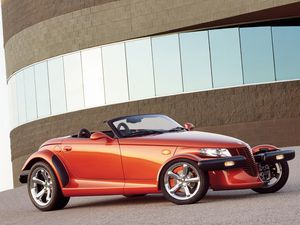.
Plymouth Prowler: Difference between revisions
192.249.47.8 (talk | contribs) (→Photos) |
192.249.47.8 (talk | contribs) (→Photos) |
||
| Line 146: | Line 146: | ||
===Photos=== | ===Photos=== | ||
[ | [http://www.prowleronline.com/scrapbook/00000206/trailer2.gif] | ||
===Colors=== | ===Colors=== | ||
Revision as of 14:19, 20 April 2009

| |
| Plymouth Prowler | |
|---|---|
| Chrysler / Plymouth | |
| aka | Prowler |
| Production | 1997, 1999-2002. Total Production: 11578 |
| Class | Roadster |
| Body Style | 2-door Convertible |
| Length | 165" |
| Width | 76" |
| Height | 51" |
| Wheelbase | 113" |
| Weight | 2,838 lbs |
| Transmission | Auto-Stick, final drive ratio is 3.89; individual gears are: 2.842 1st, 1.573 2nd. 1.000 3rd. and 0.689 (overdrive) 4th. |
| Engine | 3.5L V6 |
| Power | 1997: 214HP, 221 ft lb @ 3,100 RPM; 1999-2002: 253HP, 255 lb-ft @ 3,950 RPM |
| Similar | Honda S2000, Audi TT, Porsche Boxster, BMW Z3 |
| Designer | Chip Foose |
The Prowler is Plymouth's tribute to a truly original American art form: the street rod.
Styled like a roadster of the 1930s, but redone in the mode of the '50s, the Prowler looked like no other modern car on the road. Motorcycle-type front fenders, for instance, moved along with the front wheels. Like the Viper before it, Prowler had been a show car--but one later made ready for the street. Appearances aside, the Prowler's technology was strictly up-to-date. About 900 pounds of aluminum were used--in the hood, front side panels, doors, rear deck, frame, bumpers, front-suspension wishbones, and seat frames. Plastic was used for rear body panels, rocker panels, and front fenders. Borrowed from Chrysler's LH sedans, the 3.5-liter V6 engine produced 214 horsepower. Rear-wheel drive helped impart a more traditional hot rod feel. Prowler's sole transmission was a rear-mounted automatic unit with Chrysler's Autostick manual-shift feature, which permitted manual gear selection when desired. Antilock brakes and traction control were not available, though brakes were all-disc. Front tires were 225/45VR17 size, while the back end held massive 295/40VR20 rubber. Both tires had run-flat capability--essential because there was no room for a spare tire. The retro theme continued into the interior, which featured a full complement of gauges at the center of the dashboard, in an elliptical pod. That pod matched the body color--which was purple-only in the Prowler's first season. A tachometer was mounted atop the steering column, simulating the look of aftermarket speed equipment. Standard equipment included air conditioning, a tilt steering wheel, cruise control, 6-disc CD changer, and a defroster for the convertible top's glass rear window. Power windows, locks, and mirrors also were standard. Production ended February 15, 2002.
Recent Changes
1999 - Different V6 Engine, Passenger Airbag shut off, Chrome Wheels, Compass and trip odometer in rear view mirror.
Styles and Major Options
No Options Offered, only different colors.
Pricing
|
MODELS |
||||
|
1997 |
1999 |
2000 |
2001 |
2002 |
|
MSRP |
||||
|
$38,300 |
$39,300 |
$43,000 |
$44,225 |
$44,900 |
|
Invoice |
||||
|
$N/A |
$N/A |
$N/A |
$N/A |
$N/A |
Gas Mileage
City: 17 Highway: 23
As seen on the FuelEconomy.gov website, the City/Highway MPG averages are as follows:
Reliability
4 out of 5 stars Warranty: 3 years / 36 months
Safety
This section should reference points on safety ratings and features of the vehicle.
Photos
Colors
Purple (1997 & 1999) Yellow (1997-2002) Red (1999 & 2000) Black (1999 & 2000) Silver (2000-2002) Woodward (red/black) (2000) Black Tie (black/silver) (2001) Burnt Orange (2001) Blue (2001) Inca Gold (2002) Candy Apple (2002) Electric Blue (last one built, 2002)
Full Breakdown of Production Numbers can be found at: http://www.prowleronline.com/facts.php#production
Main Competitors
Honda S2000, Audi TT, Porsche Boxster, BMW Z3
Unique Attributes
The Prowler was hand assemblied (next to the Viper) at Conner Avenue Assembly Plant in Detroit, Michigan
The Prowler is a rolling celebration of new technology and materials. Staying true to its hot-rod roots, however, Prowler's architecture remains body-on-frame, and the top priorities - rigidity, strength yet light in weight - were all met with the use of tommorow's material's technology.
Sections are joined by slip-in Node and Clevis castings which are MIG welded, as are the various brackets and mounts. The robotic welding is so precisely executed that each bead has an almost jewel-like quality to it. Two alloys are used, 6061 and 6063, both in T6 temper (which is well into the hardness and strength end of the aluminum designation scales). These are expensive alloys, but relatively easy to form - and they can be further hardened to near steel equivalency through "heat aging" as well as other ways. The two alloys lend themselves to the creation of "crush" zones, and the wrinkled "dimple" near the front of the frame also collapses under impact. Provisions for the cockpit take up slightly more than the center third of Prowler's frame, assuring passenger room aplenty, and full compliance with federal safety mandates, including dual air bags* and side-impact protection.
Resale Values
$25,000-$46,000
Criticisms
No V8 engine.
Generations
Predecessor: Chrysler Crossfire
Worldwide
United States and Canada
Design quirks and oddities
There are no 1998 Prowlers
In 2001 the Prowler moved from the Plymouth lineup to Chrysler.
Only 396 Prowlers where built in 1997
Only one High Voltage Electric Blue Prowler with matching trailer was made. Signified the end of production in February 15, 2002.
Awards
None
See Also
Chrysler
Plymouth
External Links
http://www.prowleronline.com/facts.php
